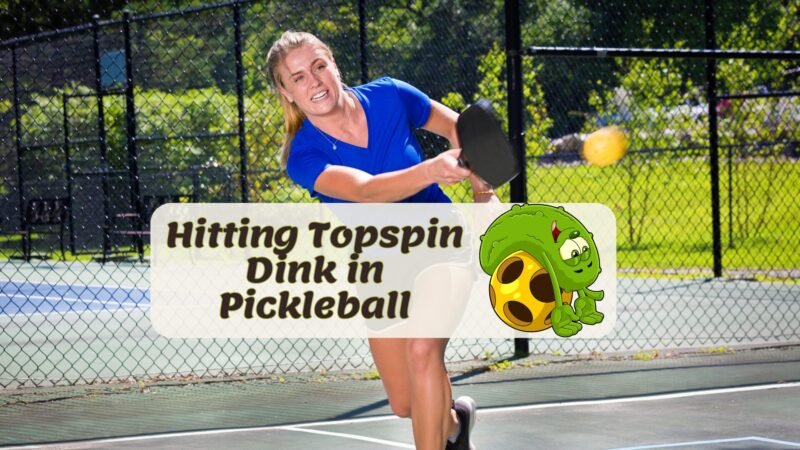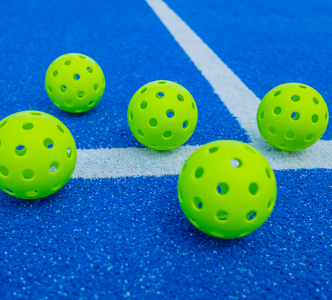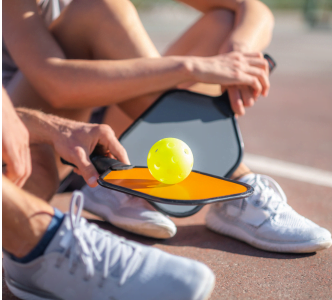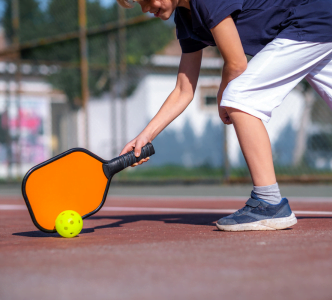If you want to improve your game, learning the topspin dink is a great move. This special shot can shake things up and keep your opponents on their toes.
I have shared with you the practical steps and my own experience about hitting topspin dink in pickleball. These tips will help you to hit topspin dink shots in pickleball with more accuracy and power.
Let me tell you in short how to hit a topspin dink in pickleball in an easy way. First of all, To hit a topspin dink in pickleball, stand in a ready position near the net. Use a continental grip and bend your knees slightly. Swing your paddle low to high, brushing the ball’s backside to create topspin. Aim for the opponent’s kitchen, ensuring the ball dips quickly after crossing the net.
Practice this shot to make it a powerful part of your game strategy. now let’s move on to the in-depth practical steps.
What is the Official Forehand Cross Court Topspin Dink in Pickleball?
It’s a mouthful, but don’t worry, it’s simpler than it sounds. Imagine you’re standing near the net, paddle in hand. You’re about to hit the ball, but instead of a flat hit, you add a little twist. That’s right, you’re putting some topspin on it. This means the ball will spin forward as it flies over the net.
Why is this so cool? Well, topspin makes the ball dip down faster after crossing the net. It’s like adding a little magic to your shot. The ball doesn’t just sail over; it dives into your opponent’s court, making it harder for them to hit back.
Now, let’s talk about the “Dink Dip.” It’s a catchy name, right? The Dink Dip is all about adding that topspin to your dink shots. This isn’t just about looking fancy. It’s a strategy to outsmart your opponent.
With the Dink Dip, you’re not just keeping the ball in play, you’re setting yourself up for the win. You’re making it tough for your opponent to predict where the ball will go. And when they finally get to it, the topspin might just throw them off, giving you the upper hand.
So, why should you care about this topspin dink? Because it’s a game-changer. It adds a new layer to your pickleball skills. You’re not just playing the game, you’re playing it smart. With the Forehand Cross Court Topspin Dink, you’re not just hitting the ball; you’re making it work for you.
The Mechanics of Topspin Dink
If you understand how topspin works that’s the key to mastering this shot. When you hit the ball with topspin, you’re making it rotate forward as it moves through the air. This spin affects how the ball behaves when it hits the ground. Instead of bouncing straight up, a ball with topspin will bounce forward and down, making it trickier for your opponent to hit back.
So, how do you hit a topspin dink in pickleball? Let’s break it down step by step:
- Get in Position: Stand near the net with your knees slightly bent and your paddle ready.
- Grip and Angle: Hold your paddle with a continental grip, and angle the paddle face slightly upward.
- The Swing: Start with your paddle low, then swing upward, brushing the back of the ball as you hit it. This brushing motion is what creates the topspin.
- Follow Through: Continue your swing in an upward motion, following through after you hit the ball to ensure you’ve imparted enough spin.
Advice from my experience: The key to a successful topspin dink is the brushing motion. You’re not just hitting the ball; you’re spinning it. With practice, you’ll start to feel the difference in how the ball behaves, and you’ll see how it can give you an edge in your games.
Proper Grip and Stance for Executing a Topspin Dink
Mastering the topspin dink in pickleball is all about getting the basics right. Hold your paddle with a continental grip, where your base knuckle is on top of the handle. This grip gives you the control you need for that perfect spin. Stand with your feet shoulder-width apart, knees slightly bent, and weight balanced. This stance keeps you ready to move in any direction.
in my recent article about pickleball tips for intermediate players, I have shared the techniques and strategies that helped me to grow my pickleball skills effectively I recommend that if you are an intermediate player make sure to note down those tips and if you are a beginner and want to know about some beginner pickleball tips, so stay in touch with our tips and strategies category.
Now, for the Forehand Cross Court Topspin Dink, position yourself close to the net, on your forehand side. When the ball comes your way, use a smooth, upward motion to brush the back of the ball, creating that topspin. Aim for the cross-court corner of your opponent’s kitchen. This shot not only adds spin but also places the ball where it’s tough for your opponent to return.
But watch out for these common mistakes:
- Hitting Too Hard: This isn’t about power. It’s about finesse. Hit too hard, and you’ll lose control.
- Wrong Paddle Angle: If your paddle face is too open or too closed, you won’t get the right spin.
- Poor Footwork: Stay on your toes and move with the ball. Bad footwork leads to bad shots.
Why is the Forehand Cross Court Topspin Dink Important?
You might be wondering, why all this fuss about the Forehand Cross Court Topspin Dink. Well, this shot is a game-changer in pickleball. It’s not just about hitting the ball over the net; it’s about hitting it with purpose and strategy.
The topspin dink has some fantastic advantages. For starters, it keeps your opponents guessing. The spin makes the ball dip quickly, forcing it to hit upward and potentially popping the ball up for you to smash. It also adds variety to your game, keeping your playstyle dynamic and unpredictable.
Strategically, the topspin dink is a great tool in matches. Use it to move your opponents around the court, breaking their rhythm. It’s especially effective when you’re aiming for the corners of the kitchen, making it harder for your opponent to return the ball without stepping into the no-volley zone.
There are two main questions about this shot that you should understand.
What is a Dead Dink in Pickleball?
A dead dink in pickleball is a shot that has minimal bounce and spin, making it challenging for the opponent to return with force. It’s a strategic shot that can disrupt your opponent’s rhythm and set you up for a winning play. The key to a successful dead dink is to hit the ball softly and with precision, aiming for it to land close to the net in the opponent’s kitchen.
How to Speed Up a Dink in Pickleball?
Speeding up a dink in pickleball can add an element of surprise to your game. To do this, use a firmer wrist and a slightly more aggressive swing than you would for a standard dink. The goal is to increase the pace of the ball while still maintaining control and keeping it low over the net. This can catch your opponent off guard and force them into a defensive position.
Drills to Perfect Your Topspin Dink
Practice makes perfect, especially when it comes to the topspin dink. Let’s dive into some drills that will help you perfect this shot.
Solo Drills:
- Wall Bounce: Stand a few feet from a wall and gently hit the ball against it, focusing on adding topspin. Try to keep the ball going as long as possible.
- Target Practice: Set up a target in your practice area, like a cone or a spot on the wall. Practice hitting your topspin dink towards the target, aiming for precision.
Partner Drills:
- Dink Rally: Stand at opposite ends of the kitchen and rally the ball back and forth, focusing on adding topspin to each shot. Keep the rally going to build consistency.
- Cross-Court Challenge: Stand on diagonal sides of the court and practice hitting the topspin dink cross-court to each other. This will help you master the angle and spin needed for the shot.
Tips for Hitting the Perfect Topspin
Here are some tips to help you nail it every time:
- Getting Under the Ball: Position your paddle below the ball as you prepare to hit. This helps you brush up on the ball, creating that essential topspin.
- Hitting the Ball Out in Front: Make contact with the ball in front of your body. This gives you better control and direction, ensuring your dink lands just where you want it.
- Using the Right Muscles: Engage your core and use your shoulder muscles to power your shot. This helps you maintain control while adding the necessary force for a topspin dink.
- Maintaining Paddle Position: Keep your paddle face angled slightly upward throughout the shot. This ensures you consistently apply topspin to the ball.
Avoid These Mistakes While Hitting This Shot
Overhitting the Ball
One common mistake is hitting the ball too hard. Remember, the topspin dink is more about finesse than power. Aim for a gentle, controlled shot that just clears the net and dips quickly.
Incorrect Paddle Angle
Another error is having the wrong paddle angle. Your paddle should be slightly open but not too much. If it’s too flat, you won’t get enough spin. If it’s too open, the ball might pop up, making it easy for your opponent to attack.
Poor Footwork
Good footwork is crucial for a successful topspin dink. Make sure you’re in the right position to hit the ball. If you’re too far or too close, your shot might not have the desired effect.
Advanced Tips and Tricks
The pickleball rules are changing every year so make sure to keep yourself up to date whenever you read about any tips or tricks here are my 3 main tips that work best.
Number 1:
One advanced tip is to adjust your topspin dinks based on your opponent’s style. If they struggle with fast shots, add more spin to make the ball dive quicker. If they’re better at handling spin, mix in some flat dinks to keep them guessing.
Number 2:
The condition of the court can also affect your topspin dinks. On a windy day, you might need to hit with more spin to ensure the ball lands where you want it. On a slower court, a little less spin might be more effective.
Number 3:
Finally, incorporating topspin dinks into your overall game strategy is crucial. Use them to set up powerful smashes or to move your opponent out of position. By mastering the topspin dink, you’ll add a valuable weapon to your pickleball arsenal.
Learning from the Pros
Studying the Pros
One of the best ways to improve your topspin dink is to watch how the pros do it. Many professional pickleball players have mastered this shot, using it to gain a strategic advantage in their matches. By analyzing their techniques, you can learn valuable lessons to apply to your own game.
Technique Breakdown
Pay attention to how pros position their bodies, the angle of their paddles, and the timing of their shots. Notice how they use topspin dinks to control the pace of the game and keep their opponents off balance. These details can provide insights into how to execute the shot effectively.
Strategic Insights
Beyond technique, observe the strategy behind the use of topspin dinks. Pros often use this shot to set up a winning play or to recover from a difficult position. Understanding the tactical applications of the topspin dink can elevate your overall game strategy.
Conclusion
Let’s quickly recap what we’ve covered. The topspin dink is a valuable shot in pickleball, adding depth and strategy to your game. We’ve gone through the mechanics of the shot, tips for mastering it, and common mistakes to avoid. Also discussed was how to hit a topspin din in pickleball, how to adjust your topspin dinks based on your opponent and court conditions, and how to integrate them into your overall game strategy.
Now, it’s time to take these tips to the court. Practice is key to perfecting your topspin dink. So grab your paddle, hit the court, and start experimenting with this game-changing shot. With dedication and practice, you’ll soon see the impact of topspin dinks in your matches. Go ahead and give it a spin!
FAQ’s
Can I use a topspin dink in singles play as effectively as in doubles?
Yes, you can use a topspin dink effectively in singles play. It’s a versatile shot that can help you control the pace of the game and keep your opponent on their toes. By adding topspin, you can make the ball dip quickly, making it harder for your opponent to attack, regardless of whether you’re playing singles or doubles.
How do I counter an opponent’s topspin dink?
To counter an opponent’s topspin dink, focus on staying low and keeping your paddle up. Anticipate the ball’s quicker bounce due to the topspin and aim to hit it back with a flat or slightly open paddle face to neutralize the spin. Practice responding to topspin dinks to improve your reaction time and shot accuracy.
What’s the difference between a topspin dink and a slice dink?
A topspin dink is hit with an upward brushing motion, causing the ball to rotate forward and dip quickly. A slice dink, on the other hand, is hit with a downward motion, imparting backspin that makes the ball float and skid, potentially staying low after the bounce. Both have strategic uses depending on the game situation.
Can topspin dinks be used effectively in windy conditions?
Topspin dinks can be effective in windy conditions as the spin can provide more control over the ball’s trajectory. However, it’s important to adjust your shot based on the wind’s direction and strength. In strong winds, you may need to apply more spin or hit with a flatter trajectory to maintain control.
How can I practice topspin dinks if I don’t have a partner?
If you don’t have a partner, you can practice topspin dinks against a wall or a pickleball rebounder. Focus on hitting the ball with the correct paddle angle and follow-through to generate topspin. You can also practice footwork and positioning to simulate game-like conditions and improve your overall technique.
Are there any specific drills to improve the accuracy of my topspin dinks?
Yes, there are specific drills to improve the accuracy of your topspin dinks. One effective drill is to place targets in different areas of the opponent’s kitchen and practice hitting your topspin dinks to land on or near these targets. This helps you develop precision and control over the placement of your shots.







